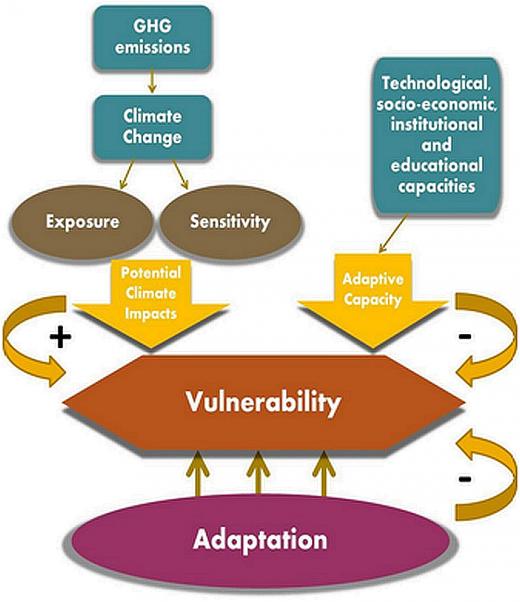Issues:
Sectors:
Keywords:
1. Why is adaptation needed?
The understanding that climate is indeed changing is widely received and policy makers discussed both mitigation and adaptation strategies on national and international levels. Adaptation, however, has received more attention only recently. It has emerged as an essential strategy to reduce adverse effects of climate change that cannot be avoided anymore, as well as to exploit beneficial socioeconomic opportunities since no mitigation effort can prevent climate change impacts in the next few decades1. Additionally, some impacts have already been observed. (Knowledge Package Adaptation Policy in the EU – An Overview provides an overview of different areas in which climate change can have an effect in Europe.) Moreover, it is important that policy makers are aware of the interlinkages between mitigation and adaptation and that therefore independent decision-making is not recommended (see Knowledge Package Mitigation: Co-Benefits and Interlinkages to Adaptation).
1.1 Vulnerability as a key concept of adaptation
Closely related to the need of adaptation is the concept of vulnerability. This is the case, because factors like adaptive capacity or sensitivity have effects on vulnerability and adaptation mainly seeks to reduce vulnerability2. The concept of vulnerability is used in many scientific disciplines with slightly different interpretations. In social sciences, however, vulnerability is defined as the predisposition of people, wealth and landscape to be adversely affected3. Fig. 1 shows how vulnerability is determined by the two components exposure and sensitivity, translated into potential climate impacts, and by adaptive capacity. While climate impacts increase the vulnerability of a region or system, an increase in adaptive capacity can reduce vulnerability. Moreover, a system that is highly exposed and sensitive to climate change, but has a high adaptive capacity might be less vulnerable than a system that is less capable to adapt.
It follows that adaptation is needed everywhere, but more urgently in areas that are more vulnerable to climate change and have less adaptive capacity. Often these are countries and regions that do not have sufficient financial resources to invest in climate adaptation. In addition, along with information about efficient adaptation, the tools for provision of adaptation are also missing. Particularly developing countries and small island states are hit by these shortcomings. The most vulnerable types of European regions, however, are discussed in Knowledge Package Adaptation Policy in the EU – An Overview.
2. The dimensions of climate adaptation
Adaptation measures are undertaken both by public and private actors through policies, investments in infrastructure and technologies and behavioural change4. Public action is required, for example, when the government acts as the landowner (roads, bridges etc.) or if significant social organization is needed (flood control barriers or irrigation channels) or because adaptation undertaken by private actors need to be facilitated by the provision of public goods (e.g. adjustment to regulatory framework, information provision)5. Adaptation is considered rather private, however, if private individuals act individually to minimize losses from climate change5.
Another way to distinguish between adaptation types is based on the timing, goal and motive of its implementation1. Anticipatory adaptation refers to action that is taken in advance of impacts becoming observable, whereas reactive adaptation is applied after observing initial impacts of climate change. Adaptation in natural systems is reactive by nature; in human systems, however, it can be both anticipatory and reactive1. Table 1 summarizes anticipatory and reactive adaptation measures for the natural system as well as for public and private actors.
3. Aggravating factors for adaptation processing
3.1 Barriers to adaptation decision-making
Since public and private actors are involved in the implementation of adaptation measures, decision-making barriers may reduce the desired level of adaptation. From an economic point of view, there are several barriers that prevent governments from adaptation decision-making, such as transaction costs. Other barriers emerge due to market failures such as externalities, information asymmetries, and moral hazards. The 5th Assessment Report of the International Panel on Climate Change (IPCC) (2014) provides a comprehensive literature survey identifying the following economic barriers to adaptation decision-making6:
- Transaction costs. These are mainly divided into information and adjustment costs. The former referring to the costs that occur when acquiring information and the latter to the costs that come along with replacement decisions of long-lived capital.
- Market failures and missing markets. These include externalities, information asymmetries, and moral hazards. This is particularly the case when considering maladaptation if adaptation actions of one economic unit negatively affect the damages of one other unit (individual, firm, country, or sector). These market failures also include the problems that arise with insufficient incentive structure and therefore assign a major role to public authorities.
- Behavioural obstacles to adaptation. Includes all behavioural issues that lead to irrational decisions without using all the available information and are time inconsistent. Social norms and cultural factors also have an inadequate influence on adaptation-decision making.
- Ethics and distributional issues. These issues connect to the aforementioned differences in vulnerability and adaptive capacity. Usually economic approaches suggest choosing the most cost-effective projects, but ethical concerns imply that adaptation decision-making needs to account for both the net benefits and the impacts on equity.
- Coordination, government failures, and political economy. Even though public decision-makers are supposed to remove the barriers listed above, they themselves face similar barriers such as insufficient knowledge or resources. Moreover, most adaptation measures require high coordination between different governance levels.
- Uncertainty. This represents one of the largest barriers to adaptation since it is expands into different dimensions: future developments of demographics, technologies and economics, and future climate change6.
3.2 Different limitations to adaptation
Passing the decision-making barriers, however, does not imply that adaptation can overcome all climate change effects, leaving residual impacts. Figure 2 shows obstacles to the adoption of some adaptation strategies and therefore to the elimination of some climate change effects.
The outermost circle of Fig. 2 gives the adaptation space that basically defines the adaptation need. Hence, all actions are included that would be required to avoid all negative effects and capture all positive effects of climate change. Since the size of this space is determined by climate change, mitigation can help reducing this space. The second circle represents a subset of all needed adaptation actions including all actions that are technically and physically feasible. So, what cannot be adapted to, are unavoidable impacts. By investing in research and development, the area of "what we can do" can be expanded and therefore former unavoidable impacts become partly avoidable. Out of these possible adaptation actions, a new subset is formed that represents all desirable actions considering limited resources and competing priorities. Consequently, some actions are simply too expensive to implement even though they would be technically practicable. In general, adaptation strategies are desirable when benefits from adaptation measures are larger than the costs to implement the measures. In order to increase the number of desirable adaptation actions, a country needs more disposable resources that can be dedicated to adaptation. This can be achieved, for instance, by higher economic growth. Finally, the smallest subset of adaptation strategies includes the actions that will actually be implemented6.
4. Conclusion
Climate change related adaptation is needed in complementarity with mitigation since mitigation alone is not enough to stave off the adverse effects of climate change. Greater rates and magnitudes of climate change increase the likelihood of exceeding the limits to adaptation. Also the opportunities to take advantage of positive synergies between adaptation and mitigation may decrease with time, particularly if adaptation limits are exceeded3. Not only private, but also public actors are required to implement adaptation measures, because individuals are often confronted with barriers, and incentives are often not sufficient to reach the desired level of adaptation. However, strategies to expand the limits of adaptation reach from investing in research and development, increasing economic growth, to "simply" reducing the extent of climate change. The key for an efficient adaptation policy is to be aware of and to overcome these limitations, as well as the decision-making barriers to adaptation (check out the Knowledge Package Mainstreaming Climate Change Adaptation in the EU for more information on effective mainstreaming).


![The dimensions of adaptation| Examples for the natural system, and for public and private actors in the human system crossing anticipatory and reactive adaptation measures| Source: Adapted from Richard J.T. Klein, “Adaptation to Climate Variability and Change: What is optimal and appropriate?”, in Climate Change in the Mediterranean: Socio-Economic Perspectives of Impacts, Vulnerability and Adaptation, C. Giupponi and M. Schechter (eds.), Edward Elgar (Cheltenham [UK], 2003), pp. 32–50. The dimensions of adaptation| Examples for the natural system, and for public and private actors in the human system crossing anticipatory and reactive adaptation measures| Table 1| Source: Adapted from Richard J.T. Klein, “Adaptation to Climate Variability and Change: What is optimal and appropriate?”, in Climate Change in the Mediterranean: Socio-Economic Perspectives of Impacts, Vulnerability and Adaptation, C. Giupponi and M. Schechter (eds.), Edward Elgar (Cheltenham [UK], 2003), pp. 32–50.](sites/default/files/styles/body_width_520_pix/public/table1_3.jpg%3Fitok=xyPlxSha)
![Adaptation action is limited by different factors| The narrowing of adaptation: from what is needed to what will be implemented| Source: M. Chambwera, G. Heal, C. Dubeux, S. Hallegatte, L. Leclerc, A. Markandya, B.A. McCarl, R. Mechler, and J.E. Neumann, 2014: Economics of adaptation. In: Climate Change 2014: Impacts, Adaptation, and Vulnerability. Part A: Global and Sectoral Aspects. Contribution of Working Group II to the Fifth Assessment Report of the Intergovernmental Panel on Climate Change [Field, C.B., V.R. Barros, D.J. Dokken, K.J. Mach, M.D. Mastrandrea, T.E. Bilir, M. Chatterjee, K.L. Ebi, Y.O. Estrada, R.C. Genova, B. Girma, E.S. Kissel, A.N. Levy, S. MacCracken, P.R. Mastrandrea, and L.L. White (eds.)]. Cambridge University Press, Cambridge, United Kingdom and New York, NY, USA, pp. 952. Adaptation action is limited by different factors| The narrowing of adaptation: from what is needed to what will be implemented| Figure 2: Only a small subset of all suggested adaptation measures will be implemented due to technical and physical limits as well as to differences in objectives.| Source: M. Chambwera et al. 2014](sites/default/files/styles/body_width_520_pix/public/fig2_0.jpg%3Fitok=-8pckGZH)